|
Van Arty Association and RUSI Van Members News Oct 20, 2015 Newsletter on line. This newsletter, and previous editions, are available on the RUSI Vancouver website at: http://www.rusivancouver.ca/newsletter.html Wednesday Lunches The 15 Field Officers Mess holds weekly lunches, serving a 5 course, ‘homemade’ meal for only $15- you won’t find a better meal - or a better deal, anywhere. If you are in the area on a Wednesday, drop in and join us for lunch. NOABC Speaker Program - Wednesday October 28th Mr John Swann will give a talk on the `San José` and the hunt for its Treasures. The Spanish galleon San José was trying to outrun a fleet of British warships off Colombia on June 8, 1708, when a mysterious explosion sent it to the bottom of the sea with gold, silver and emeralds owned by private Peruvian and European merchants, and lies about 700 feet below the water’s surface, a few miles from the historic Caribbean port of Cartagena, on the edge of the Continental Shelf. The San José is known to have been part of Spain’s only royal convoy take colonial gold to King Philip V during the War of Spanish Succession (1701–1714). The treasure is reportedly worth $4 billion to $17 billion. “Without a doubt, the San José is the Holy Grail of treasure shipwrecks,” Robert Cembrola, director of the Naval War College Museum in Newport, R.I., said. World War 2 - 1940 John Thompson Strategic analyst quotes from his book “Spirit Over Steel” Oct 14th: The Italian War Council believes it can take Greece in two weeks and elects not to tell the Germans about their planned offensive. Goering is planning a prolonged night bombing offensive on England. Oct 16th: Registration begins for the Draft in the US. Oct 18th: The British reopen the Burma Road to China, built with enormous effort in 1937 the mountain trail lets trucks – just – reach China. The Vichy Government enacts a series of laws restricting Jews from public service and positions of authority. The Wolf Pack tactics are working as six U-Boats prove by sinking 36 ships in the peak attacks on Convoys SC-7 and HX-79. Oct 20th: Italian bombers from Eritrea hit refineries in Bahrain and Saudi Arabia. Oct 21st: Five Italian destroyers pounce on a British convoy in the Red “Sea, causing no harm but losing one of their own. Oct 23rd: At the summit between Franco and Hitler, the Spanish leader won’t ally with Germany without a long list of crucial supplies (carefully calculated to be rejected); Franco’s demands irritate Hitler.  Premiere Screening of Reunion of Giants Premieres Remembrance Day 2015 in Select Cineplex Theatres Across Canada The last two airworthy WWII Lancaster Bombers reunited over England to make history in 2014. A war relic from Canada crossed the Atlantic to meet her counterpart in the UK and for the first time in 50 years two Lancasters shared the sky for a reunion tour. The Canadian Warplane Heritage Museum Lancaster, VeRA, flew from Hamilton, Ontario to meet her British counterpart, Thumper—the only other airworthy Lancaster in the world—operated by the Royal Air Force in England. It was a mission unlike any other this Lancaster and her flight crew had ever undertaken. Two legendary bombers, separated by time and distance, met in Bomber County to fly together, this time in peace. The reunion was also a farewell tour to veterans of Bomber Command, who are so entwined in their proud history. These marvels of mechanical engineering are part of a proud lineage credited with bringing an end to WWII. First-hand accounts from those who were connected to the bomber during the war transport us back in time as they share what it was like during the Lancaster’s glory days. REUNION OF GIANTS documents this historic mission as it unfolds, through the eyes of the flight crews and veterans—all part of the bombers’ history, including this new chapter as VeRA crosses the Atlantic. Participating theatres will be announced this September with free tickets becoming available beginning October 2, 2015. For information on tickets, theatre locations and future DVD availability, please visit warplane.com. The lower mainland free screening will be held at the Cineplex at International Village in Vancouver @ 7 pm and tickets are available at the box office which opens 30 minutes prior to the screening.  MV Asterix before conversion MV Asterix before conversion Interim Supply Ship for RCN MONTREAL, September 11, 2015 – L-3 MAPPS announced today that Chantier Davie Canada Inc. and Project Resolve Inc. have selected its Integrated Platform Management System (IPMS) for the conversion of the container vessel MV Asterix into an Auxiliary Oil Replenishment (AOR) ship for the Royal Canadian Navy’s interim supply ship capability. “L-3 MAPPS is a recognized world leader in automation for naval vessels built to commercial marine as well as military standards and has extensive experience in ship upgrades for customers worldwide,” said Rangesh Kasturi, president of L-3 MAPPS. “We are pleased to be chosen by Chantier Davie and Project Resolve for this innovative project to support the RCN’s urgent requirements and we look forward to the implementation contract being finalized shortly. We have been very impressed with the ‘Team Canada’ approach for the project and are looking forward to making our contribution.” “Project Resolve will provide the RCN with a critically important replenishment at-sea capability,” said Spencer Fraser, chief executive officer of Project Resolve Inc. “We are extremely proud to have assembled a pan-Canadian supply chain that will feature ‘best-of-breed’ naval technologies developed and produced here at home by Canadian personnel. L-3 MAPPS is a trusted partner with a fantastic pedigree of supporting the RCN and exporting Canadian naval technology worldwide. The company will be bringing a very modern and proven capability to our iAOR solution.” 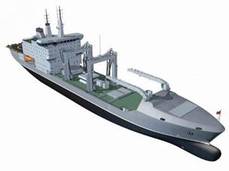 After conversion After conversion Using technology pioneered in Canada, the L-3 MAPPS IPMS provides comprehensive monitoring and control of a ship’s propulsion, electrical, ancillary, auxiliary and damage control machinery systems. With advanced functionality, such as the Battle Damage Control System, Onboard Team Training System, Equipment Health Monitoring System and CCTV, as well as integration with the ship’s combat management and navigation systems, the IPMS allows the crew to safely and effectively operate the ship for all mission requirements. L-3 MAPPS’ technology is used by 18 navies worldwide and is installed on most of the RCN’s major warships and submarines. The company also provides advanced Safety Management Systems for some of the world’s newest and largest cruise ships and naval auxiliary vessels. Chantier Davie Canada Inc. is Canada’s largest and highest-capacity shipbuilder and industrial fabricator. Davie provides a broad range of products and services to industries from offshore oil and gas to defence. Certified to ISO 9001:2008, Davie leverages its high-capacity fabrication facilities with its advanced project management and engineering capability to manage end-to-end construction projects and provide best-practice through-life solutions to its corporate and governmental clients. Davie was voted North American Shipyard of the Year (2015) by Lloyd’s List. In the meantime, the Chilean Navy ship, Almirante Montt, has been rented by DND to act as a supply ship for the Pacific fleet. It arrived at the naval base in Victoria on July 3 and will be available for 40 sea days, an RCN spokesman said. Negotiations are still underway with Spain for the provision of a supply ship to be used for the RCN's Atlantic fleet. 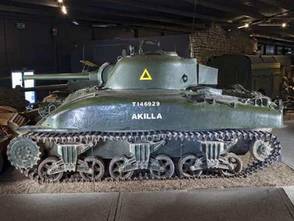 Auction Hammer Falls on this Canadian Grizzly Tank David Pugliese, Ottawa Citizen October 17, 2015 A Canadian-made Second World War tank, a Grizzly 1, recently sold at auction for $155,000, according to Live Science magazine. The Grizzly 1 was a variant of the Sherman tank Nicknamed ‘Sherman’ after the American Civil War General William Tecumesh Sherman, the M4 Medium Tank played a vital role during World War Two. The second most populous Allied tank behind the Russian T-34, it was designed with reliability, ease of production / repair and mobility in mind. Palpably superior to the German Panzer III and IV tanks upon its debut with the British Army at El Alamein in autumn 1942, the Sherman was outclassed by later Third Reich designs in terms of armour, range and speed but continued to triumph often due to sheer weight of numbers. The Montreal Locomotive Works, responsible for equipping the nascent Canadian Armoured Divisions since the fall of France, switched from making the M3-based ‘Ram I/II’ to the M4-based ‘Grizzly I’ during autumn 1943. Understandably similar to its American counterpart, the latter boasted the same vertical volute suspension, traversing turret, 5-man crew, 75mm armament and Continental 9-cylinder 350hp radial engine. Grizzlies were initially fitted with US tracks but a lot of were converted to Canadian Dry Pin (CDP) tracks which were lighter, simpler and more tarmac friendly yet did not require rubber (a scarce resource following the Japanese advance into Southeast Asia). Within months it became obvious that demand for Sherman tanks was being met by existing US facilities. As a result the Montreal Locomotive Works completed just 188 Grizzlies before re-tooling for the Sexton MKII self-propelled gun. Grizzlies were reportedly used for training on both sides of the Atlantic rather than for frontline combat, nonetheless it is thought that a few were deployed to Italy. Better preserved than their US contemporaries, some fifty-odd Grizzlies were sold to Portugal during the 1950s as part of the NATO military assistance programme. Despite reputedly participating in the Angolan War of Independence, the Grizzlies’ remarkable state of preservation suggests that it has never come under heavy fire. It has been loaned to various museums over the past thirty-one years including its present circa two decade stint at IWM Duxford, and is said to require minor recommissioning prior to use. CT160194, notable as the very first of the 188 made, has been in the current ownership since 1984. Noting that work is needed to various electric and hydraulic cables, the vendor variously rates the Grizzly as ‘excellent’ (engine, manual transmission, body), ‘excellent / good’ (paintwork) or ‘good / fair’ (interior). More complete and original than many of the Shermans that have come to market in recent years, CT160194 – a.k.a. Grizzly No.1 – has its own place in history.  In this 2014 photo provided by Pacific Wrecks, Justin Taylan, founder and director of Pacific Wrecks poses at a Second World War airplane wreck site in Papua New Guinea (PNG). (Marcus Browning/Pacific Wrecks via AP) In this 2014 photo provided by Pacific Wrecks, Justin Taylan, founder and director of Pacific Wrecks poses at a Second World War airplane wreck site in Papua New Guinea (PNG). (Marcus Browning/Pacific Wrecks via AP) Adventurer Uncovers Lost WWII Planes for the Pentagon ALBANY, N.Y. -- Justin Taylan has been to the remote Pacific island nation of Papua New Guinea dozens of times over the past two decades, spending countless hours slogging through crocodile-infested swamps in his quest to document as many Second World War airplane wreck sites as possible. Since 2013, he has conducted those missions for the newly reorganized Pentagon agency whose predecessor he and others had criticized for years for failing to recover and identify more remains of US service members. Taylan's hiring is part of the military's plans to reach out to private groups and others to help with the search for thousands of American war remains scattered from Pacific jungles to the European countryside. Though he said he cannot comment on the details of the cases he's worked on under his contract, Taylan said he has documented more than 80 wreck and war-related sites, including eight aircraft crashes associated with American MIA cases. "So many organizations have something to give and share," Taylan, 37, told The Associated Press recently in between trips to Papua New Guinea. "It's an incredible turn of events to support the mission and get more MIA cases resolved." The Pentagon lists 83,000 MIAs as unaccounted-for from the Second World War and the Korean and Vietnam wars. More than 73,000 are from the Second World War, with many of those deemed not recoverable because they were lost at sea. In 2009, Congress set a requirement that the Pentagon identify at least 200 sets of remains a year by 2015. But less than half that number has been identified over each of the past two years. Earlier this year, the Department of Defence unveiled its revamped Defence POW/MIA Accounting Agency, a move that came a year and a half after the AP obtained an internal Pentagon study that criticized previous efforts as being in danger of spiraling from "dysfunction to total failure." In a shift many critics say is long overdue, the new agency is working with non-profit organizations such as Taylan's Pacific Wrecks, Inc. and private firms to help with research and actual searches. Other examples: - An Ohio archaeology firm was hired this summer to search for the remains of 1Lt Ewart Sconiers, a bombardier who died in a German POW camp in Poland in 1944. - History Flight, a Marathon, Florida-based organization, recovered the remains of 36 Marines killed on the Pacific atoll of Tarawa, one of the war's bloodiest battles. The remains were brought to Hawaii for identification in late July. - Leaders of the University of Wisconsin's Missing in Action Recovery and Identification Project plan to meet with military officials in Washington this month to discuss collaborations utilizing the college's DNA and genetics expertise. Last year, UW-Madison helped identify the remains of Pfc Lawrence S Gordon, a Canadian-born US soldier killed in France in 1944. The university's MIA project leaders recently met with members of Kuentai-USA, a Japanese group that has found Japanese and US MIAs on Saipan, scene of a major battle in 1944. Hundreds of Americans are still listed as MIA in Papua New Guinea. Most were air crews who disappeared when their planes crashed in forbidding terrain that includes dense jungles and cloud-shrouded mountain peaks topping 13,000 feet (3,900 metres). Taylan, who lives in Hyde Park, N.Y., began visiting the southwest Pacific after taking a trip to the Philippines in 1993 with his grandfather, a former Second World War Army photographer who served there. Taylan became fascinated by the numerous wartime plane wrecks and battle artifacts still visible and started a website, pacificwrecks.com, to document wreck sites, battlefields and MIA cases across the Pacific. Taylan has visited hundreds of wreck sites and passed along any new information he gathered to the Pentagon. He eventually joined veterans’ organizations and others who criticized the government for taking in some cases decades to provide families with details about their loved one's loss during the Second World War. Mark Shoemaker can attest to that frustration. His uncle, 2Lt Edward F Barker, disappeared in Papua New Guinea during a training flight in 1944. A US military team visited the wreck site in 1962 but found no remains. The site was revisited 40 years later, and again in 2012, when human remains were finally recovered. Barker's remains weren't identified until July, when they were returned to his hometown in New York's Mohawk Valley for burial. Although Taylan wasn't involved in the discovery of Barker's remains, the Pacific Wrecks website had numerous details about the case, right down to the serial numbers on the fighter plane's machine-guns. Taylan attended the funeral and met Shoemaker, who said he's encouraged that people outside the Pentagon are being brought in to help with MIA missions. "The government has to be involved in some way, but there's certainly a place for these guys," Shoemaker said. "There's obviously a lot of room for improvement."  (Photo: Heckler & Koch) (Photo: Heckler & Koch) Soldiers Can Set When Grenade Explodes With New Launcher By Kyle Jahner5:16 p.m. EDT October 12, 2015 The maker of a new grenade launcher that can fire rounds that explode when they pass walls or barriers is "finalizing development" of a weapon it believes will give soldiers a serious edge. XM25 carries a magazine of five 25mm grenade rounds and a fire-control system that lets the soldier instantly program how far the grenade will travel before it explodes. That means a soldier can engage an enemy hiding behind a target — only he doesn't need to hit something to ruin the enemy's hiding place and his day. According to XM25 maker Orbital ATK spokesman Jarrod Krull, in spring the Army will conduct qualification testing and contract validation. If the weapon fulfills the Army's requirements, the Army could see fielding in early 2017, Krull said — assuming budget decisions also line up in the weapon system's favor. "It provides combat overmatch; the ability to engage the target in defilade (shielded)," Krull said.  A 25mm grenade round for the XM-25 Photo: Obital ATK A 25mm grenade round for the XM-25 Photo: Obital ATK When a soldier aims the weapon at a target, a laser finder gauges distance. The soldier can add or subtract from that distance with the push of a button and then, after setting the distance, can aim and fire. The fire control also shows a soldier how high to aim the weapon to account for gravity's pull on the grenade based on the laser-determined distance. The company says the range is 500 meters to a target point, and 600 meters to an area target. The weapon itself, made by Heckler & Koch, consists of lightweight material composites. Brashear made the fire control and Orbital ATK produced the munitions and integrated the system. 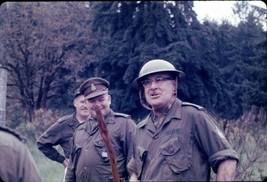 Who is it? Last Week: Only had a couple of replies on this one. Nobody knew anything about CWO Wood but he is not a Gunner. Behind him is Capt Howie Costain, RCOC (Note the earplug container- the CF was just starting to get concerned about hearing protection). Behind him is Sgt Gordy Wright. Gord was a WOII in the 43rd MAA and was one of many who had to take a reduction in rank (and also had to rebadge to RCASC) to stay in when the 43rd amalgamated with 15th Fd. He was an excellent cook and ran the Regiment’s kitchens in the field for many years. No one identified the location but we are pretty sure it was Ft Lewis. 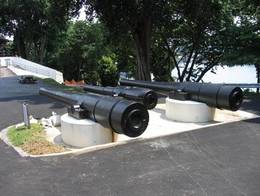 This Week: This week we take a break from our “Who’s that chap” series, and switch to our other “What’s that big thing” series, featuring long, metallic objects. Most of these potentially loud objects are painted khaki, olive drab, or other camouflage variations. However, these three are simply painted black, because they have not seen service for many, many years. These artillery pieces are mounted on concrete, obviously not their original mounts, although one never knows with budget cutbacks and so forth. Two, very large guns, appear to be the same type, whilst the one in the middle is much smaller and of a different make. All three are aimed at a picnic table, but it is thought that this is simply an accident, and no hostility is intended. Your task, should you rise to the bait, is to identify the three artillery pieces, and, as a bonus, identify the current location, which, we hasten to add, is not in Vancouver, but is, or was, a bastion of the Empire. Your ideas can be sent to the editor, or to the author, John Redmond ([email protected]). Thank you in advance. From the ‘Punitentary’ Singing in the shower is all fun and games until you get shampoo in your mouth - then it just becomes a soap opera. Murphy’s other Laws Profanity is the one language understood by all soldiers. Quotable Quotes The three great essentials to achieve anything worthwhile are, first, hard work; second, stick-to-itiveness; third, common sense. - Thomas Alva Edison 15th Field Artillery Regt Seeking Recruits
Primary Reserve Artillery Information Session Monday October 19th, 2015 @ 6:00 P.M and Monday October 26th, 2015 @ 6:00 P.M Those interested in applying to the Canadian Armed Forces Primary Reserves are welcome to attend a one-hour information session as a first step in the recruitment process. These sessions will include information on career availability, benefits, training, and more. Registration is mandatory for all information sessions 2025 West 11th Ave, Vancouver BC To register, call 604-666-4371 or email [email protected] Be sure to include the following information: · Your name and address · Phone number (home, work, cell) · Email address · Date and time of presentation |
Archives
June 2024
|

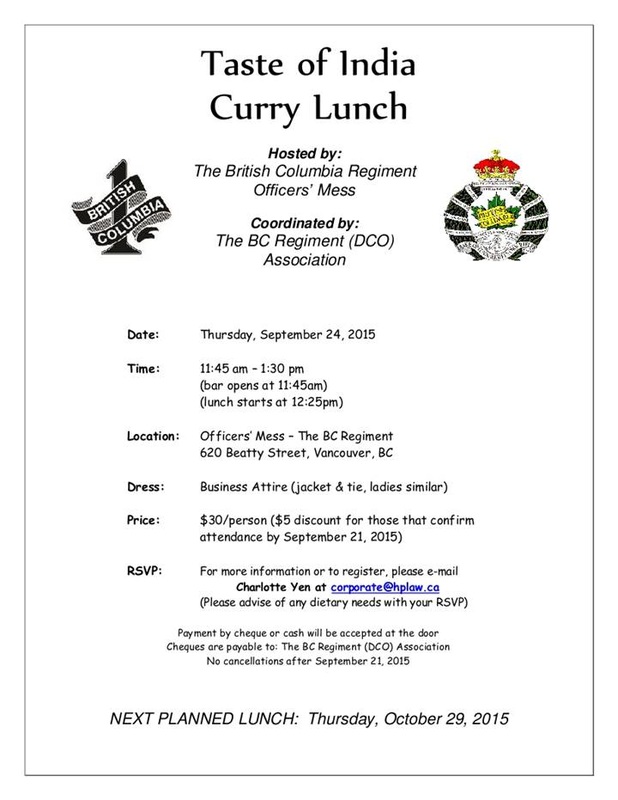

 RSS Feed
RSS Feed